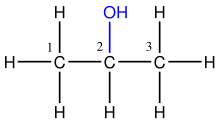Prefixes and Suffixes in Chemistry
Prefixes and suffixes are part of the nomenclature of compounds in chemistry . Together with the root name of a connection, they form the name for it. A prefix is the syllable that precedes the parent compound and a suffix is the syllable that follows it.
use
The nomenclature proceeds as follows: The functional groups and the side chains are named in alphabetical order according to the IUPAC rules , counting syllables such as di-, tri- etc. not counting for the order. The number indicating the position of the functional group is separated by a hyphen and written in front of the prefix and the stem name. There can also be several prefixes in front of a stem name, then they are simply separated by a hyphen, as can be seen in the example of 3,5-dibromo-2-chloro-5-ethyl-1-nitrooctane. The stem name is chosen so that it contains as many functional groups and side chains as possible.
There are functional groups, such as the hydroxy group (-OH), which can be written either as a prefix (hydroxy-) or a suffix (-ol). It usually depends on the other functional groups.
Only one functional group can act as a suffix; if there are more than one functional group, the most senior one is formulated as a suffix. All others are then described by prefixes, this happens in the order mentioned above. In addition, only prefixes and no suffixes are used when naming the substituents on side chains. The position number of the substituent called the suffix can also be placed in front of the suffix, as in propan-2-ol, or directly in front, then it would be called 2-propanol .
Many functional groups have a carbon atom that can either be regarded as part of the parent chain or not. Hence, there are two ways to refer to this functional group as a suffix. For example, if you add the carbon atom of the carboxy group (-COOH) of the main chain of a carboxylic acid , the name is given by the suffix “-acid”. If, however, the carbon atom of the carboxy group is not considered to be part of the parent chain, the designation results from the suffix “- carboxylic acid ”.
Examples
| Compound class | functional group | prefix | suffix | Example with name |
|---|---|---|---|---|
| diazonium salts |
|
-diazonium- salt |
Benzene diazonium chloride |
|
| Ammonium salts |
|
-ammonium- salt |
Tetramethylammonium chloride |
|
| Salts of carboxylic acids |
|
-oat |
Sodium propanoate |
|
| Carboxylic acid | -COOH | Carboxy | -acid -carboxylic acid |
CH 3 -COOH acetic acid |
| Salts of sulphonic acids |
|
sulfonate |
Sodium benzene sulfonate |
|
| Sulfonic acid | -SO 3 H | Sulfo- | sulfonic acid |
C 6 H 5 SO 3 H benzenesulfonic acid |
| Carboxylic acid esters |
–COOR | Alkoxycarbonyl | -carboxylic acid- alkyl esters -alkyl acid esters |
CH 3 - COOCH 3 methyl acetate |
| Carboxylic acid halides |
–COHal | Halocarbonyl | -carboxylic acid halide -acid halide |
CH 3 -COCl acetic acid chloride |
| carboxylic acid amides |
-CONH 2 | Carbamoyl | - carboxamide - acid amide |
CH 3 -CH 2 -CONH 2 propanoic acid amide |
| alkylated carboxylic acid amides |
–CONHR (–CONR 2 ) |
Alkylamino carbonyl |
-carboxylic acid- alkylamide -acid alkylamide |
CH 3 -CH 2 -CON (CH 3 ) 2 propanoic acid dimethylamide |
| Nitriles | -CN | Cyano | -carboxylic acid nitrile- acid nitrile |
CH 3 –CH 2 –CN propanoic acid nitrile (cyanoethane) |
| aldehyde | –CHO | Oxo- (formyl-) | -al |
CH 2 O oxomethane ( formaldehyde ) CH 3 –CHO |
| Ketones |

|
Oxo- | -on |
 Propanone ( acetone ) |
| Alcohols | -OH | Hydroxy | -oil |
CH 3 –CH 2 –OH ethanol (hydroxyethane) |
| Phenols | -OH | Hydroxy |
C 6 H 5 OH phenol (hydroxybenzene) |
|
| Ether | –OR | Alkoxy |
CH 3 –CH 2 –O – CH 3 ethyl methyl ether (methoxyethane) |
|
| Peroxides | -O-O-R | -peroxy- |
2-hydroperoxypropane |
|
| Thio alcohols | –SH | Mercapto- | -thiol |
CH 3 –CH 2 –SH ethanethiol (mercaptoethane) |
| Epoxides (oxiranes) |
|
Epoxy |
 Epoxypropane ( methyloxirane ) |
|
| Amines | -NH 2 -NH-R |
Amino- alkylamino- |
CH 3 -NH 2 methylamine CH 3 -CH 2 -NH-CH 3 |
|
| Nitro compounds |
-NO 2 | Nitro |
CH 3 -CH 2 -NO 2 nitroethane |
|
| Nitroso compounds |
–NO | Nitroso |
C 6 H 5 -NO nitrosobenzene |
|
| Iodine compounds |
–I | Iodine |
CH 3 I iodomethane |
|
| Bromine compounds |
–Br | Bromine- |
CH 2 Br 2 dibromomethane |
|
| Chlorine compounds |
-Cl | Chlorine- |
HCCl 3 trichloromethane ( chloroform ) |
|
| Fluorine compounds |
–F | Fluorine- |
F 2 HC-CHF 2 1,1,2,2-tetrafluoroethane |
See also
literature
- Lothar Döhring, Günther Golisch: Fundamentals of organic chemistry . 4th edition. VEB Deutscher Verlag für Grundstoffindindustrie, Leipzig 1981 , pp. 18-21; Order number : 541 204 1.
- Adalbert Wollrab: Organic Chemistry. An introduction to teacher training and minor subjects . 3. Edition. Springer Verlag, Berlin Heidelberg 2002 , pp. 43–46; ISBN 978-3-540-43998-1 .


